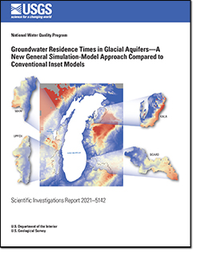Groundwater Residence Times in Glacial Aquifers—A New General Simulation-Model Approach Compared to Conventional Inset Models
Links
- Document: Report (6.69 MB pdf) , HTML , XML
- Data Release: USGS data release - MODPATH-NWT and MODPATH6 models used to compare a new general simulation model approach with a conventional inset model approach for groundwater residence time in glacial aquifers
- Download citation as: RIS | Dublin Core
Abstract
Groundwater is important as a drinking-water source and for maintaining base flow in rivers, streams, and lakes. Groundwater quality can be predicted, in part, by its residence time in the subsurface, but the residence-time distribution cannot be measured directly and must be inferred from models. This report compares residence-time distributions from four areas where groundwater flow and travel time were simulated with conventional simulation-inset models (IMs) and with a new automated model-construction method called general simulation models (GSMs). The comparison provides an opportunity to explore controls on travel time and improve the methods used in the creation of GSMs. These models can be useful for three main-use cases: (1) rapid testing of relationships that govern groundwater flow and age, (2) generation of consistent examples for training a machine-learning metamodel, and (3) serving as a starting point for more detailed models.
Comparison of the GSMs to IMs indicated a qualified pattern of agreement for residence-time distributions as indicated by the Nash-Sutcliffe efficiency and Spearman’s correlation coefficient. The agreement was best for the median values of the simulated residence times in young fractions of groundwater (defined as the fractions of groundwater in samples less than 65 years old) at the scale of the eight-digit hydrologic-unit code. Generally, the median values of the young fractions in the IMs were correlated with the median values from the GSMs. The relative trends across the four areas also were similar for the other residence-time metrics. The medians of residence-time metrics at finer scales show a fair degree of scatter. The GSM results compared most poorly for median travel times in the older fraction of groundwater (older than 65 years).
The GSM approach is intended as a flexible framework for developing models that can be useful individually as screening tools or collectively to support projects in statistical learning. Although one set of GSM algorithms was presented here, the approach can accommodate many types of data and also different categories of prior information. Comparison of GSMs and IMs suggests ways in which the GSMs, while remaining easy to construct and calibrate, can be improved for estimating groundwater travel times. IMs do not yield exact travel times, and matching GSMs to IMs does not guarantee an improvement; however, IMs provide a convenient benchmark against which to explore relations between physical characteristics of watersheds and the distribution of travel times within them.
This effort was undertaken as part of the National Water Quality Program of the U.S. Geological Survey to assist in determining the susceptibility of groundwater in glacial aquifers to a variety of natural and anthropogenic contaminants.
Suggested Citation
Starn, J.J., Kauffman, L.J., and Feinstein, D.T., 2023, Groundwater residence times in glacial aquifers—A new general simulation-model approach compared to conventional inset models: U.S. Geological Survey Scientific Investigations Report 2021–5142, 37 p., https://doi.org/10.3133/sir20215142.
ISSN: 2328-0328 (online)
Study Area
Table of Contents
- Abstract
- Introduction
- Methods
- Results
- Discussion
- Future Work
- Summary and Conclusions
- Acknowledgments
- References Cited
- Appendix 1. Description of the General Simulation Models
| Publication type | Report |
|---|---|
| Publication Subtype | USGS Numbered Series |
| Title | Groundwater residence times in glacial aquifers—A new general simulation-model approach compared to conventional inset models |
| Series title | Scientific Investigations Report |
| Series number | 2021-5142 |
| DOI | 10.3133/sir20215142 |
| Publication Date | June 01, 2023 |
| Year Published | 2023 |
| Language | English |
| Publisher | U.S. Geological Survey |
| Publisher location | Reston, VA |
| Contributing office(s) | New England Water Science Center, New Jersey Water Science Center, Wisconsin Water Science Center |
| Description | Report: v, 37 p.; Data Release |
| Country | United States |
| State | Illinois, Indiana, Michigan, Wisconsin |
| Online Only (Y/N) | Y |
| Additional Online Files (Y/N) | N |


